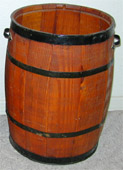 |
Barrels, casks
|
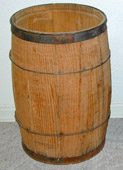 |
 |
Barrels, casks
|
 |
Be a cooper.
Coopers were artisans who made casks and barrels. A barrel has a flat bottom, and if needed, a flat lid. Its sides are shaped from wooden staves held together by iron bands. The staves are slightly wider in the middle, and that causes the barrel to be rounded and not cylindrical in shape. Because many products were transported and sold in barrels years ago, computing the volume of a barrel was an important skill. It was called gauging.
You can make a barrel shape, and other shaped containers, from poster board, index cards, and even construction paper, as follows:
|
(1) Make a regular polygon to be the bottom. Probably the easiest one to work with is a square. (For your first container, you may prefer to print out this pattern, which has a square bottom.) A pentagon is elegant. And an octagon already gives your barrel a really round look. You must make one "stave" for each side of the base, so making a container with an octagonal base requires at least twice as much work as making one with a square base. If you make a bottom that is a regular polygon other than a square, your can find out what each angle should measure here. |
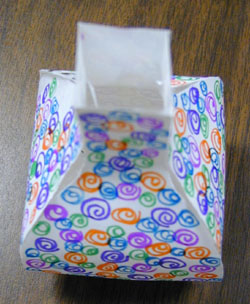 |
||||
| (2) Make your staves all the same, with vertical symmetry, and with gently curved sides. If they are wider in the middle, you get a normal barrel shaped container. If you make them narrow at the waist, you will get a "vase" shape. With some experience you will be able to create very fancy shapes. (We found that using a French curve gives elegant shapes.) To make a stave, fold an index card in half horizontally or vertically. Make a mark on the edge of the card that is half the width of your container's base. Start at the mark, and draw a curved line up to the top of the card. (As mentioned, you can do this with a French curve.) Now cut along the curved line, cutting both halves of the card. Unfold the card, and you have a stave with vertical symmetry. Its base should exactly fit the base of your container. Make as many more staves (identical to the first one) as you need, depending on the number of sides of your base. Remember that the shape of the container is completely determined by the polygon at the base and the shape of its staves. Staves 4 or 5 inches long and approximately 1 inch wide are easy to work with. |
|
||||
| (3) Build your container bottom up. First attach your staves to the base. Then connect them together with small pieces of Scotch tape. Usually three or four pieces are sufficient to keep two staves together. You will notice that in order to have staves touch each other, they must be bent. Do it gently. They should fit each other smoothly along their whole length. | 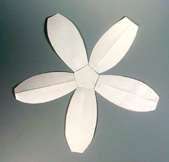 |
||||
| (4) In order to provide stability to your container, put a few pennies, nails, nuts, bolts, or pebbles inside so it will not lie on its side as this one. | 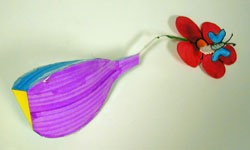 |
||||
Activities.
Before making barrels and other containers, students should have some experience with making polyhedra, because making curved sides requires more manual skills. They should also already have a set of containers for measuring volume. They should know how to measure the volume of an irregular container by filling it with rice and then measuring the volume of rice.
For the first activity the teacher should bring a complete container and patterns for the staves. Students just trace the teacher's patterns, cut them out, and fix them together. After that, they measure the volume of their containers. Using attractively colored materials is important (the easiest to work with are colored index cards). Students may work in groups during these early activities. As a follow-through students should design their own staves.
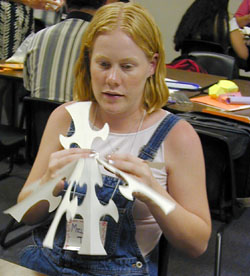 |
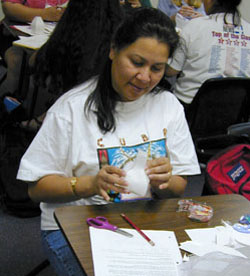 |
The discussion about the relation of the shape of the staves and the shape of containers should be initiated, but no definite answers are expected. The volumes of all containers should be measured in all activities.
For the final project each student should make his or her own design which is later displayed as part of a class project. (It is difficult to estimate ahead of time how much practice each student will need to get enough skill to make an attractive design.)
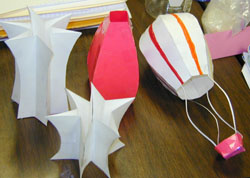 |
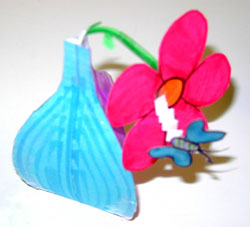 |
Volume of a barrel
Computing the volume of irregular objects can be difficult. But a very good approximation can often be obtained without much trouble.
Consider any object, and think about the areas of its cross sections by the planes parallel to its base.
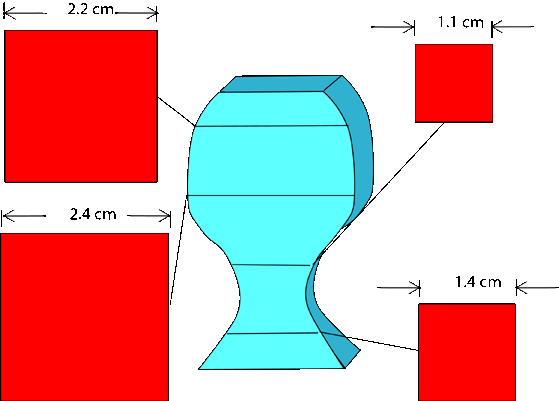
Figure 1
Each red square shows the area A of a cross section at level L above the base and, having area A(L).
Theorem.
The volume V can be approximated by the average, M, of the areas of evenly spaced cross sections, times the height h,
V = M*h
Increasing the number of cross sections increases the accuracy of the estimate. The exact position of the cross sections stops playing a role when their number increases.
Example 1. (See figure 1 above)
Height 8 cm.
| Level L |
Side
|
Area A |
| 1 cm | 1.4 cm | (1.4 * 1.4) = 2.0 sq. cm |
| 3 cm | 1.2 cm | (1.2 * 1.2) = 1.4 sq. cm |
| 5 cm | 2.4 cm | (2.4 * 2.4) = 5.8 sq. cm |
| 7 cm | 2.2 cm | (2.2 * 2.2) = 4.8 sq. cm |
average M = 14/4 =3.5 sq. cm.
Thus, V = 3.5*8 = 28 cu. cm, is the estimate of the volume.
Example 2.
For a barrel with a square bottom and not too rounded sides, it is enough to measure the width of several equally spaced cross sections of one stave. Then compute the average of the squares of the widths (these are the areas of the cross sections) and multiply their average by the height of the barrel.
For other shapes of the bottom, the formulas for the areas of a triangle, pentagon, hexagon, and other figures must be used. Here are approximate values for regular polygons with side length a.
| regular polygon | approximate area |
| equilateral triangle | 0.43 a2 |
| square | a2 |
| pentagon | 1.7 a2 |
| hexagon | 2.6 a2 |
| heptagon | 3.6 a2 |
| octagon | 4.8 a2 |
| nonagon | 6.2 a2 |
| decagon | 7.7 a2 |
| undecagon | 9.4 a2 |
| dodecagon | 11.2 a2 |
Remarks
1. The theorem that is presented above is usually formulated in terms of calculus, but to use it, one needs to know only some arithmetic and some geometry.
2. Students may measure the volumes of their containers by filling them with rice and dumping the rice into beakers having milliliter scales. They may then compare these volumes with the ones above.